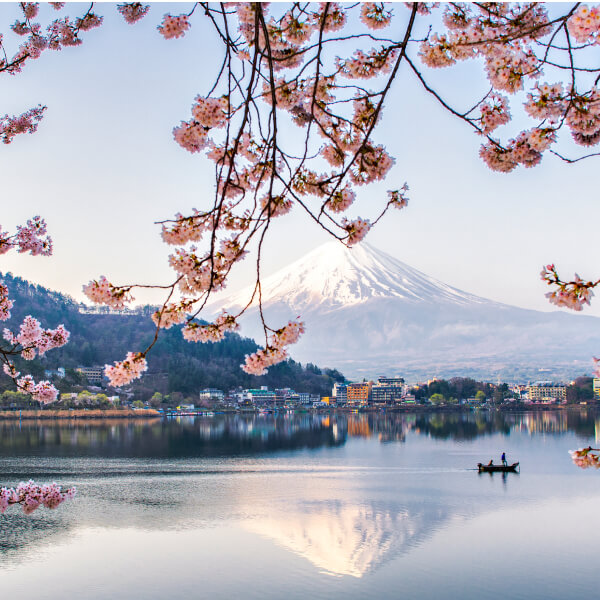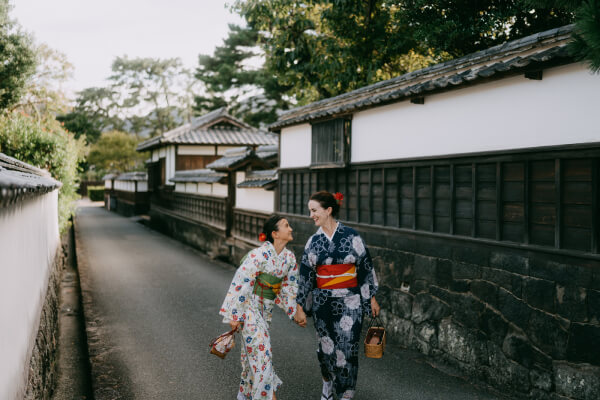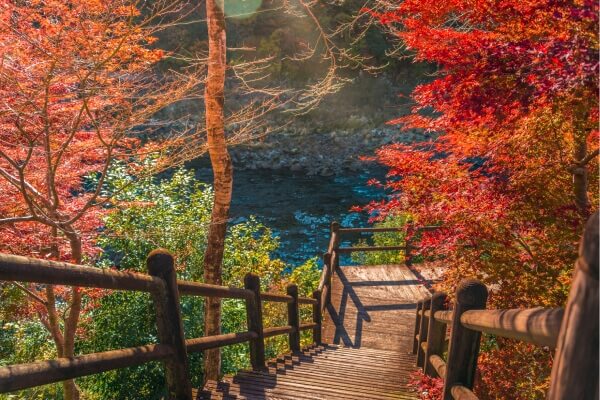From the sprawling, light-flooded metropolis of Tokyo to rural remote pockets dotted with rising mountains and steaming hot springs, travelling to Japan is like nowhere else in the world.
Cities to visit in Japan
1. Tokyo
With no end of things to do in Tokyo, dive headfirst into this pulsing metropolis. First, get your bearings by perching at one of Tokyo’s sky-high bars like the Two Rooms in Aoyama or the Park Hyatt Shinjuku penthouse bar for the best views of the city’s famous skyline.
Back on the ground, Tokyo is an endless source of visual eye candy and adventure so make sure to try as many weird ‘only in Japan’ experiences as you can. Visit the insane Kawaii Monster Cafe, have your own real-life Mario Kart race, be mesmerised by the locals at Takeshita-dori, shop at the insane Don Quijote store, have tea with a hedgehog at Hedgehog Cafe Harry or drinks with robots at the renowned Robot Cafe.
Tokyo is a foodie haven, so hop between the hundreds of specialty eateries – try Kondo in Ginza for tempura, Chukasoba Suzuran in Shibuya for ramen, Ukaitei in Ginza for Teppanyaki (a kind of Japanese BBQ) and the Tsukiji fish market for the freshest sushi.
2. Kyoto
The Japan of yesteryear, Kyoto is a trip back to the imperial days; a place of serene temples, perfectly manicured gardens, seasonal reverence and famed geisha. From quiet strolls along the Philosopher’s Walk, a cherry-tree lined canal running between the magnificent Ginkaku-ji and Nanzen-ji temples, to meandering at dusk through the backstreets of Gion, Kyoto resonates old-world Japan at every turn.
Seeing the vermillion gates at the beautiful mountainside shrine, Fushimi-Inari-Taisha is an experience not to be missed. Be sure to go either at sunset or sunrise, both to see a view you aren’t likely to forget, and to beat the considerable crowds. While in Kyoto, head over to nearby Nara, the first permanent capital of Japan and home to the Great Buddha, wandering deer and eight UNESCO World Heritage Sites.
3. Hiroshima
The power of regeneration is all too evident in modern-day Hiroshima, a city forever linked to the devastating atom bomb that struck in 1945. Today, it’s a destination for millions of tourists and while all come to pay their respects to the events of the past, it’s now a city with a sunny, laid-back attitude that warms everyone’s hearts.
Spend time in the Peace Memorial Park and museum, scour the Hiroshima Museum of Art and take a day trip to the nearby island of Miyajima to capture the majestic view of the orange gate standing proud in the ocean.
4. Hokkaido
Those keen to ski Japan are usually well acquainted with Japan’s northern-most island of Hokkaido. Rugged and remote, it’s the country’s second-largest island and home to only five per cent of the population. The capital, Sapporo, held the winter Olympics in 1972, opening up its towering mountains and perfect powder to the world. For those less inclined to ski, the city’s annual snow festival, 19th century Sapporo Beer Museum and bubbling hot springs are sure to divert.
Hokkaido is also famous for its seafood - visit Nijo Market to see and sample King Crabs as big as your head, sea urchin, and all manner of weird and wonderful creatures from the deep.
Keen for a little skiing in Japan that’s closer to Tokyo? Hakuba in the Nagano Prefecture is easier to reach and offers 10 resorts, hundreds of runs and western and Japanese style accommodation.
5. Osaka
Good food, warm humour and an enterprising spirit radiate from Osaka, setting the tune for your travels. Located in a uniquely flat landscape, the region has been a primary rice-growing area for centuries, instilling the locals with a down-to-earth nature and robust sense of community.
Perhaps a little quiet and reserved during the day, the city comes alive at night, where lights, tasty street food and entertainment quarters beckon. Feast on the local treats ‘takoyaki’, grilled octopus dumplings and ‘okonomiyaki’, pancakes, get a buzz walking through the blazing lights of entertainment district Dotonbori and take a peek at the Osaka Aquarium.
Unmissable things to do in Japan
1. Explore natural wonders and ancient temples in Nikko
An easy day trip from Tokyo but well deserving of spending a night or two, Nikko is the gateway to Japan’s famed Toshogu shrine. Marking the entry to the Nikko National Park, it’s around 140km north of the capital and is a serene mountain wilderness far from the city’s frenetic pace.
With postcard-worthy views at every turn, expect mossy, wooded hillsides, quaint hump bridges, towering cedar trees and glowing red lanterns. At its prettiest in autumn, when shades of red blanket the landscape, it’s well worth a peek – and don’t forget to visit Lake Chuzenji.
2. Celebrate the cherry blossom season
Come spring, magnificent soft pink cherry blossoms flower throughout Japan, starting in the warmer south and travelling up to the north. This annual ritual is a time to celebrate the beauty of nature as the country is blanketed in a spectacular pink flower cloud.
Cherry blossom viewing parties are held throughout Japan where people come together to enjoy this majestic site. Some popular areas for Cherry blossom festivals include the castle town of Hirosaki, Ueno Park in Tokyo and Yoshino Yama in Nara Prefecture.
3. Watch Sumo wrestling
From the ‘chanko nabe’ stews they eat to bulk up, to the ornate silk belts and top-knots worn for tournaments, sumo wrestlers are a rare and fascinating breed in Japan. Full of ritual and tradition, their sport has its origins in Shinto religion and has been practiced for centuries. There are six tournaments held every year: three in Tokyo (January, May and September) and one each in Osaka (March), Nagoya (July) and Fukuoka (November).
4. Visit Tokyo Disneyland
Tokyo Disney offers an overwhelming dose of Disney magic just 15 minutes by train from Tokyo Station. This enormous sprawling park is clean, organised and brimming with excited families keen to experience as much of this wonderland as time and queues permit.
Immensely popular, expect long waits for rides so plan out your day, map your plan of attack and use your allocated fast passes to ensure you don’t miss too much. Accommodation is available at Disneyland Japan for those keen to extend the dream over a few days.
5. Spot a Geisha
Geisha have mesmerised the west for centuries, with Arthur Golden’s 1997 historical fiction novel ‘Memoirs of a Geisha’ fuelling our fascination. These skilled female artists have been an integral part of Japanese culture since ancient times,, entertaining clients by singing, dancing, playing music and engaging in conversation.
Modern day Geisha still exist, although their numbers are dwindling, and glimpses of them can be caught as they flit to and from appointments in the backstreets of Gion in Kyoto.
.png)


